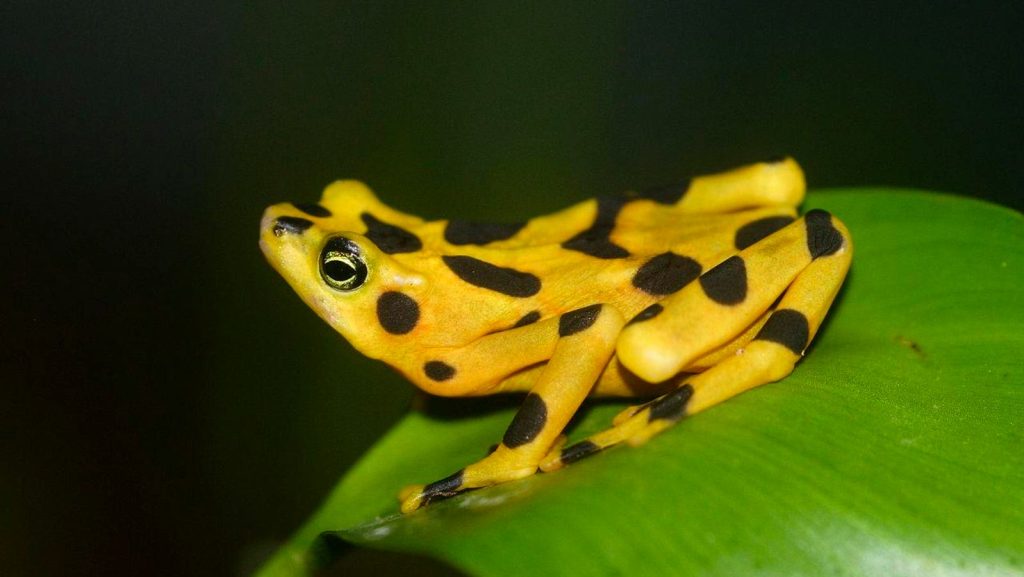A fungus that is devastating populations of frogs and toads around the world may be vulnerable to a virus that can infect it, and that scientists could be genetically engineered to kill it
A deadly fungus that is devastating frogs and toads around the world may in fact be vulnerable to a virus that can infect it. The fungus, Batrachochytrium dendrobatidis also known as Bd or the amphibian chytrid fungus, causes chytridiomycosis in amphibians. This fungus is a pathogen that infects and destroys the skin of frogs and toads, eventually causing heart failure due to electrolyte loss.
Bd is causing a global pandemic that has either contributed to or caused the probable extinction of 90 amphibian species, including the Panamanian golden frog, Atelopus zeteki, or the severe declines of more than 500 amphibian species.
A team of researchers at the University of California at Riverside, recently announced their discovery of a virus that infects Bd. Further, they think it can be genetically engineered to control or destroy the fungal disease, thereby saving declining amphibian populations.
“Frogs control bad insects, crop pests, and mosquitoes,” said study co-author microbiologist Mark Yacoub, a doctoral student at UCR. “If their populations all over the world collapse, it could be devastating.”
In addition to their pest control activities, amphibians also are important indicators of habitat and water quality.
“They’re the canary in the coal mine of climate change,” Mr Yacoub explained. “As temperatures get warmer, UV light gets stronger, and water quality gets worse, frogs respond to that. If they get wiped out, we lose an important environmental signal.”
Although global declines and extinctions of amphibian populations were first noticed in the 1970s and 1980s, the cause remained unidentified until 1999 when the Bd fungus was discovered. The seriousness of the pandemic began to dawn on conservationists in the early 2000s, when they realized that a disease could pose a primary threat to amphibian biodiversity that can lead directly to their extinction.
Considering its effects, Mr Yacoub and his dissertation advisor, microbiologist Jason Stajich, a professor at UCR who investigates the processes and mechanisms of evolution in fungi, were excited when they discovered the Bd-infecting virus.
“We wanted to see how different strains of fungus differ in places like Africa, Brazil, and the U.S., just like people study different strains of COVID-19,” Professor Stajich remarked. To do this work, Mr Yacoub, Professor Stajich and collaborators were using DNA sequencing technology to study the population genetics of Bd. Whilst analyzing their data, they noticed some peculiar sequences that did not match the DNA of the fungus.
“We realized these extra sequences, when put together, had the hallmarks of a viral genome,” Professor Stajich reported.
The discovery was a surprise. Previously, researchers had looked for Bd viruses but were unable to find any. But this task was quite challenging. For example, keeping the Bd fungus itself alive in the lab is tricky due to its complicated lifecycle and this may be the reason no viruses were originally detected.
“It is a hard fungus to keep track of because they have a life stage where they’re motile, they have a flagellus, which resembles a sperm tail, and they swim around,” Professor Stajich explained.
Another reason that the virus that infects Bd could evade scientists is because it is a single-stranded DNA virus, whereas most viruses that infect fungi are classified in a different class of RNA viruses, known as mycoviruses. So scientists were looking for the wrong thing. But by studying the genomic DNA sequences from a number of fungal strains, Mr Yacoub, Professor Stajich and collaborators soon spotted the virus hiding in the fungal genome.
But the virus is elusive even they know what they’re looking for: it’s only present in the genomes of some fungal strains, making it even more challenging to find.
“Because some strains of the fungus are infected and some are not, this underscores the importance of studying multiple strains of a fungal species,” Mr Yacoub pointed out.
But the virus infected Bd fungus appears to show different attributes than fungi that are virus-free.
“When these strains possess the virus they produce fewer spores, so it spreads more slowly,” Professor Stajich observed. “But they also might become more virulent, killing frogs faster.”
Currently, Mr Yacoub, Professor Stajich and collaborators plan to clone the virus to see if they can infect the Bd fungus with the clone to see which fungal attributes this replicates.
But this surprising discovery raises plenty of important questions. Perhaps most important is which molecular mechanisms does the virus use to alter fungal pathogenicity and can these mechanisms be altered to render the fungus less deadly to amphibians? What is the role of the amphibian skin microbiome itself: are some microbial species more protective than others?
“We don’t know how the virus infects the fungus, how it gets into the cells,” Mr Yacoub said. “If we’re going to engineer the virus to help amphibians, we need answers to questions like these.”
In addition to helping Mr Yacoub, Professor Stajich and collaborators learn about how fungal pathogens gain virulence and spread, this research offers the hope that science can end this global amphibian pandemic. Further, lessons learned from the Bd pandemic may also be helpful in dealing with threats posed by other pandemics of infectious diseases, such as white-nose fungus in bats.
Interestingly, although Bd is known to infect over 500 amphibian species, susceptibility is highly life stage and species specific. For example, tadpoles of the mountain yellow legged frog, Rana muscosa, generally suffer mild sublethal effects, with most mortality occurring at metamorphosis when there is a rapid production of newly keratinized skin tissue. In contrast, several other amphibian species appear to be relatively tolerant or resistant to Bd — including some widespread exotic or invasive species, such as the marine toad, Rhinella marina, American bullfrog, Lithobates catesbeianus, and African clawed frog, Xenopus laevis. These Bd resistant amphibians may also provide important clues for helping protect more vulnerable species.
Source:
Rebecca A. Clemons, Mark N. Yacoub, Evelyn Faust, L. Felipe Toledo, Thomas S. Jenkinson, Tamilie Carvalho, D. Rabern Simmons, Erik Kalinka, Lillian K. Fritz-Laylin, Timothy Y. James and Jason E. Stajich (2024). An endogenous DNA virus in an amphibian-killing fungus associated with pathogen genotype and virulence, Current Biology 34(6) | doi:10.1016/j.cub.2024.02.062
© Copyright by GrrlScientist | hosted by Forbes | LinkTr.ee
Socials: Bluesky | CounterSocial | Gab | LinkedIn | Mastodon Science | Post.News | Spoutible | SubStack | Threads | Tribel | Tumblr | Twitter
Read the full article here





